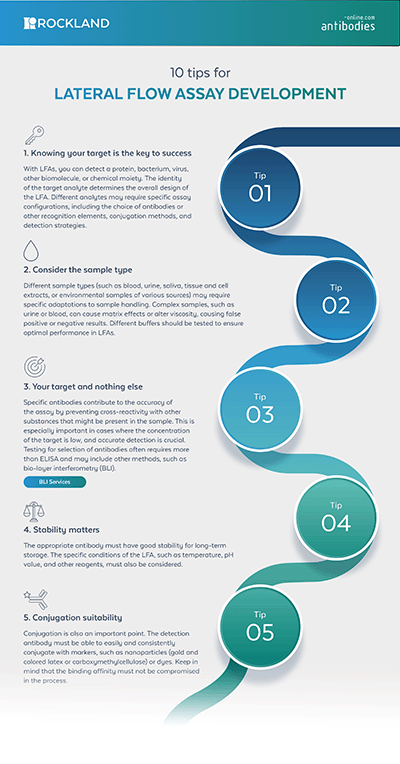10 Tips for Lateral Flow Assay Development
In developing lateral flow assays (LFAs), precision, reliability, and effectiveness are paramount. Here we present 10 crucial tips for LFA development, addressing fundamental aspects such as target identification, sample type consideration, specificity enhancement, stability, conjugation, antibody selection, material choice, future planning, learning from existing literature, and cost-quality balance. Each tip is a step towards optimizing LFA design, ensuring accurate results, and maintaining cost efficiency. These insights are invaluable for researchers aiming to enhance the performance and applicability of LFAs in various diagnostic contexts.
-
Knowing your target is the key to success
With LFAs, you can detect a protein, bacterium, virus, other biomolecule, or chemical moiety. The identity of the target analyte determines the overall design of the LFA. Different analytes may require specific assay configurations, including the choice of antibodies or other recognition elements, conjugation methods, and detection strategies.
-
Consider the sample type
Different sample types (such as blood, urine, saliva, tissue and cell extracts, or environmental samples of various sources) may require specific adaptations to sample handling. Complex samples, such as urine or blood, can cause matrix effects or alter viscosity, causing false positive or negative results. Different buffers should be tested to ensure optimal performance in LFAs.
-
Your target and nothing else
Specific antibodies contribute to the accuracy of the assay by preventing cross-reactivity with other substances that might be present in the sample. This is especially important in cases where the concentration of the target is low, and accurate detection is crucial. Testing for selection of antibodies often requires more than ELISA and may include other methods, such as bio-layer interferometry (BLI).
BLI Services -
Stability matters
The appropriate antibody must have good stability for long-term storage. The specific conditions of the LFA, such as temperature, pH value, and other reagents, must also be considered.
-
Conjugation suitability
Conjugation is also an important point. The detection antibody must be able to easily and consistently conjugate with markers, such as nanoparticles (gold and colored latex or carboxymethylcellulose) or dyes. Keep in mind that the binding affinity must not be compromised in the process.
-
Decide monoclonal or polyclonal
Monoclonal antibodies show high specificity for a particular epitope on the target and low cross-reactivity. To compensate the lower sensitivity, multiple mAbs can be combined in an assay. Polyclonal antibodies are often advantageous because they are less expensive and have higher affinities for the antigen due to their ability to recognize different epitopes. Rigorous testing is the prerequisite for finding a suitable pair for your assay.
See Products -
Select your materials carefully
Hydrophilic properties of the materials used in the LFA are crucial for promoting capillary action and maintaining an appropriate flow rate. The membrane serves as the substrate for immobilizing the capture and detection components. The material and surface properties of the membrane should be chosen to facilitate proper binding, ensuring the stability and functionality of the immobilized reagents.
-
Think about the future
Long-term availability of antibodies ensures economic stability and predictability in the production of LFAs. The use of consistent antibody batches over a long period of time ensures the reproducibility of the test results and stability of quality control during production. For this reason, use of recombinant antibodies is desirable.
See Services -
Learn from others
Reviewing scientific publications and reports where the antibody has been used successfully for similar applications may help save time and money for antibody validation.
-
Consider cost and quality
Evaluate the cost of the antibodies and the overall production process to ensure the LFA remains cost effective while meeting performance requirements. The LFA format (e.g., type of cassette or membrane holder) and sample handling accessories (e.g., collection and mixing tubes, buffers, etc.) may also significantly impact pricing. Work closely with reliable antibody suppliers or manufacturers to ensure that the antibody meets the desired requirements.
